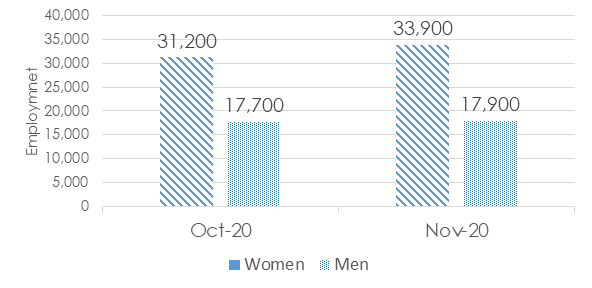Vital updates:
- The Deputy Prime Minister and Minister of Finance, the Honourable Chrystia Freeland, has announced the expansion of the Canadian Emergency Business Account (CEBA). Starting today, eligible businesses facing financial hardship as a result of the COVID-19 pandemic are able to access a second CEBA loan of up to $20,000 – on top of the initial $40,000 that was available to small businesses. Half of this additional financing, up to $10,000, will be forgivable if the loan is repaid by December 31, 2022. This means the additional loan effectively increases CEBA loans from the existing $40,000 to $60,000 for eligible businesses, of which a total of $20,000 will be forgiven if the balance of the loan is repaid on time. To apply, eligible businesses and not-for-profits need to contact the financial institution that provided their initial CEBA loan and provide the appropriate information and documentation.
- The Ontario government is moving three public health regions to new levels with stronger public health measures as set out in the Keeping Ontario Safe and Open Framework. Niagara is not one of the three regions, and our status remains unchanged, in the Orange-Restrict category. Haliburton, Kawartha, and Pine Ridge will be moved into Yellow-Protect as of Monday, December 7th, at 12:01 a.m., while Middlesex-London and Thunder Bay will move into Orange-Restrict at the same time. The Government of Ontario reminds all Ontarians that they should should avoid close contact with anyone not living in the same household. People who live alone may have exclusive close contact with one additional household to prevent feelings of isolation and mitigate against negative mental health impacts. Ontarians should also follow all required public health measures, and public health advice, as we approach the holiday season. The safest way to spend the holidays this year is by only celebrating in person with the people you live with and celebrating virtually with everyone else. People who live alone may have exclusive close contact with one additional household. The following recommendations apply to all public health unit regions in the province:
- Stay home if you have COVID-19 symptoms, even if they are mild;
- Maintain two metres of physical distancing from everyone else;
- Avoid social gatherings and limit close contacts to your household or the people you live with;
- Adhere to the restrictions in your region on public and private gatherings;
- Wear a face covering indoors and wear one outdoors if physical distancing may not be maintained or if wearing one is required;
- Wash your hands thoroughly and regularly;
- Cover your cough;
- Get tested if you have symptoms compatible with COVID-19, or if you’ve been advised of exposure by your local public health unit or through the COVID Alert mobile app;
- Individuals and families from higher transmission regions should avoid travel to lower transmission regions, except for essential reasons; and
- Download the COVID Alert mobile app.
- The Ontario government is investing $20 million to help small businesses jointly sponsor and train apprentices through the new Group Sponsorship Grant program to increase the number of people training and working in the skilled trades. The program aims to reduce pressure on any one employer to see an apprentice through to completion of training, while providing apprentices with the support needed to become a registered journeyperson. Group sponsors consist of two or more people who act as a single sponsor to collectively provide training to apprentices to grow their skills and help them gain work experience to improve their career success. The application is available to existing and new group sponsors. Successful applicants may receive funding for up to three years. Employers and organizations can apply for the Group Sponsorship Grant at Ontario.ca/hireanapprentice.
- The Ontario government is providing the Niagara Parks Commission with up to $12.81 million to help ensure the region remains one of the top tourism destinations in the world during the COVID-19 outbreak. This one-time funding is intended to help protect jobs, keep some attractions open, ensure compliance with public health protocols, and continue to keep visitors safe through policing and road maintenance activities. As both local and international travel remain uncertain, the Government of Ontario stated, it is critical that the Niagara Parks Commission continues operating and supports the recovery of the tourism sector in Ontario, continuing as a major economic hub in the Niagara Region. For more information on their COVID-19 measures and the operations of their public facilities, please visit the NPC website.
- November labour force data from Statistics Canada released today showed that the growth in employment has continued to slow, with employment rising by 62,000 (+0.3%) in November, following an increase of 84,000 (+0.5%) in October and an average of 2.7% per month between May and September. Full-time employment rose by 99,000 in November, while part-time work was little changed. Among those who worked at least half of their usual hours, 4.6 million worked from home in November. Growth in self-employment stalled in November and compared to public sector and private sector employees, employment in this group remained furthest from the February pre-COVID level (-4.7%; -136,000).
- Employment among core-aged women (25 to 54 years old) was unchanged in November after six consecutive months of growth, while employment among core-aged men rose by 23,000 (+0.4%). Employment among youth aged 15 to 24 rose 0.9% (+20,000), while the youth unemployment rate fell 1.4 percentage points to 17.4%. Employment increased among young men and was little changed for young women. Employment among workers aged 55 and older increased by 23,000 (+0.6%) in November after holding steady in October.
- Employment fell in industries most directly affected by public health restrictions, notably in accommodation and food services. On the other hand, employment continued to approach or exceed pre-COVID levels in industries where working from home or physical distancing is more feasible, such as professional, scientific and technical services. About one-quarter (26.6%) of people on temporary layoff in November last worked in the accommodation and food services industry (not seasonally adjusted). Employment in accommodation and food services declined for the second consecutive month, falling by 24,000 (-2.4%) in November, with the drop being shared between Ontario, Manitoba and Quebec. The number of public sector employees grew by 32,000 (+0.8%) in November and exceeded its pre-COVID February level by 1.5%. On a year-over-year basis, the number of public sector workers was up 61,000 (+1.6%), driven mostly by increases in hospitals and elementary and secondary schools (not seasonally adjusted).
- Local data analyzed by Niagara Workforce Planning Board revealed that November 2020 saw 300 fewer people in employment compared to October 2020. This was driven by 3,100 fewer people working in a full-time capacity and 2,800 more people working in a part-time capacity. Ideally, one would want to see gains in full-time employment with a steady or slowly increasing level of gains in part-time employment. Compared to November 2019, Niagara has 12,100 fewer people working in a full-time capacity and 4,700 more working in a part-time capacity.
- While the unemployment rate is down to 6.7% in November 2020, that is largely due to 1,500 people leaving the labour force between October and November of 2020. Both the participation rate and employment rate reflect slight month-over-month declines. A growing labour force is one where as the unemployment rate falls, the employment and participation rates increase.
- While youth employment remained steady between October and November, it too saw decreases in full-time employment and increases in part-time employment. Through a gender lens, November saw 2,300 more women in the employment and 2,500 fewer men. This is a reversal of a trend that has been in place largely since the beginning of the pandemic. But compared to this time last year, November 2020 saw 7,300 fewer employed women than November 2019.General labour force age 15 and older
Labour force characteristics 2019 2020 Oct 2019 Nov 2019 Oct 2020 Nov 2020 Labour force 215,000 215,800 213,400 211,900 Employment 204,300 205,200 198,100 197,800 Full-time employment 158,500 158,200 149,200 146,100 Part-time employment 45,800 47,000 48,900 51,700 Unemployment 10,700 10,600 15,300 14,100 Unemployment rate 5.0% 4.9% 7.2% 6.7% Participation rate 60.0% 60.1% 59.0% 58.6% Employment rate 57.0% 57.2% 54.8% 54.7% Youth Labour Force
Labour force characteristics 2019 2020 Oct 2019 Nov 2019 Oct 2020 Nov 2020 Labour force 33,000 32,200 27,000 26,100 Employment 28,900 26,800 21,800 21,800 Full-time employment 15,500 12,600 11,500 9,200 Part-time employment 13,400 14,300 10,400 12,600 Unemployment 4,000 5,400 5,200 4,400 Unemployment rate 12.1% 16.8% 19.3% 16.9% Participation rate 67.1% 65.3% 69.1% 65.4% Employment rate 58.7% 54.4% 55.8% 54.6% Full-time employment

Part-time employment

Reading recommendations:
- Reinventing Workers for the Post-Covid Economy, Eduardo Porter, The New York Times
The nation’s economic recovery from the Covid-19 pandemic will hinge to some extent on how quickly show managers can become electricians, whether taxi drivers can become plumbers, and how many cooks can manage software for a bank. What will janitors do if fewer people work in offices? What will waiters do if the urban restaurant ecosystem never recovers its density?
- Iowa Is What Happens When Government Does Nothing, Elaine Godfrey, The Atlantic
To visit Iowa right now is to travel back in time to the early days of the coronavirus pandemic in places such as New York City and Lombardy and Seattle, when the horror was fresh and the sirens never stopped. Sick people are filling up ICUs across the state. The story of the coronavirus in this state is one of government inaction in the name of freedom and personal responsibility. Iowa Governor Kim Reynolds has followed President Donald Trump’s lead in downplaying the virus’s seriousness. She never imposed a full stay-at-home order for the state and allowed bars and restaurants to open much earlier than in other places. She imposed a mask mandate for the first time this month—one that health-care professionals consider comically ineffectual—and has questioned the science behind wearing masks at all.
If you are showing symptoms, contact your health care provider, call the Public Health Info-Line at 905-688-8248, or chat to Public Health online. For testing, call 905-378-4647 ext. 42819 (4-CV19) for information on test centres in Niagara and to book an appointment.
Previous updates can be accessed here.
The GNCC is here to support you. Contact us with any questions you have.



